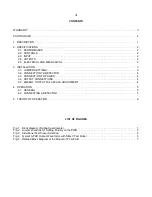
5
Fig. 4. Typical A-PAD Output Waveforms with 5-MeV Test Pulser.
4. OPERATION
4.1. GENERAL
between 0 and 100 V. The bias voltage can be
The information in Section 3 includes all of the
voltmeter. After turning ON, or adjusting, the bias
preliminary selections that are to be made for the A-
voltage, wait for the preamplifier to settle; this takes
PAD. Operation consists of connecting a detector and
about one minute.
proceeding with data collection.
4.2. CONNECTING A DETECTOR
5 V (shown in Fig. 4), if the Range is set to 4
&
6 MeV
Start with the TEST/BIAS/OFF switch in the OFF
The COUNT output should have a positive logic pulse
position. Connecting the detector with the bias voltage
with a 6-µs width (shown in Fig. 4).
ON may damage the FET transistor at the input of the
preamplifier or destroy the detector.
4. System electronic noise can be tested by
Then proceed as follows:
the MCA from the ENERGY output.
1. With the bias OFF, connect the detector to the
5. The test pulser can then be turned OFF by moving
A-PAD with a short cable (preferably RG-62A/U).
the TEST/BIAS/OFF switch to the BIAS position. The
2. Set the TEST/BIAS/OFF switch at TEST and adjust
alpha spectrometry.
the front-panel HV control for the desired bias voltage
monitored on the front-panel test point jacks with a
3. The ENERGY output should display positive,
stretched pulses at a 100-Hz rate with an amplitude of
and the TEST pulser jumper is in the 5 MeV position.
measuring the FWHM spread of the pulser peak on
A-PAD is now ready to count alpha samples or do
Содержание ORTEC A-576 A-PAD
Страница 4: ...iv ...




























